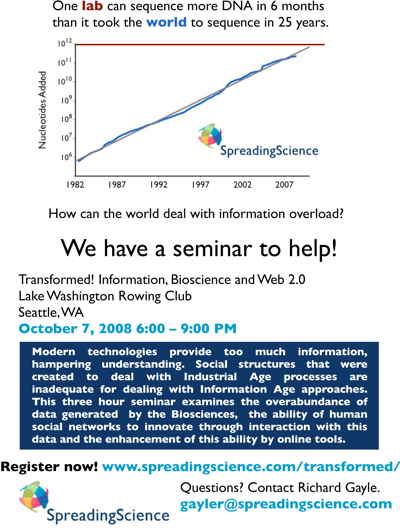 by kentbye
by kentbye
Social Media vs. Knowledge Management: A Generational War:
[Via Enterprise 2.0 Blog]
You’d think Knowledge Management (KM), that venerable IT-based social engineering discipline which came up with evocative phrases like “community of practice,” “expertise locater,” and “knowledge capture,” would be in the vanguard of the 2.0 revolution. You’d be wrong. Inside organizations and at industry fora today, every other conversation around social media (SM) and Enterprise 2.0 seems to turn into a thinly-veiled skirmish within an industry-wide KM-SM shadow war. I suppose I must be a little dense, because it took not one, not two, but three separate incidents before I realized there was a war on. Here’s what’s going on: KM and SM look very similar on the surface, but are actually radically different at multiple levels, both cultural and technical, and are locked in an undeclared cultural war for the soul of Enterprise 2.0. And the most hilarious part is that most of the combatants don’t even realize they are in a war. They think they are loosely-aligned and working towards the same ends, with some minor differences of emphasis. So let me tell you about this war and how it is shaping up. Hint: I have credible neutral “war correspondent” status because I was born in 1974.
[More]
A very clear post that describes the conflict between Boomer and Millennial thinking when it comes to dealing with large amounts of data. Knowledge management (Boomer) is a top-down put the data in the proper bin sort of approach. There are names for each bin and everything needs to fit in the correct one.
Social media (Millennial) uses human social networks in a bottom-up approach that allows the data to determine where it should go. Any bin that it should go into is an emergent property of the network created by the community.
Read the whole post for a nice dissection of what is happening in this War. Just remember that Age is not as important as attitude. There are Boomers who get social media and Millennials who do not.
I think it is that one personality wants things to be black and white (the data is in a database on THIS computer) white the other deals great with shades of gray (the data is in the cloud and not really anyplace).
I did my post-doc in a chemistry lab, the only biologist. I saw something very valuable. Chemistry is very process-driven. The purpose of a process is to reproduce success. If a process, say a particular chemical synthesis, did not work, as in the yield was 10% instead of 90%, it was not the fault of the process. The reagents were bad or the investigator was incompetent. But the process was still valid.
So chemistry selected for people who were very process-driven, wanted things very tightly controlled and well defined.
Biology has a very different regard for process. The same process (say the cloning of a gene) can be done on two different days and get different results (10 colonies of cells one day; 500 the next). Biology is really too complex to be able to control everything. A lot of things can go wrong and it can be really easy to fool oneself with results.
So biology, particularly at the cutting edge, selects for people who can filter out extraneous bits of data, can be comfortable with conditional results and with the general anarchy that can occur. Every molecular biologist has experienced the dreaded ‘everything stops working, so I have to remake every buffer, order new reagents and spend a month trying to figure out what happened, knowing that things will start working again for no real reason.’
Chemists in my post-doc lab hated biology because of the large variance in results, compared to chemistry. Biologists are often happy to be within an order of magnitude of expected results
One way of thinking has to know whether Schrodinger’s cat is dead or alive, while the other is comfortable with knowing it is simultaneously dead and alive.
Biology needs the Millenial approach because it is creating data at too fast a pace to put it all into bins. Social networks can help tremendously with the filters needed to find knowledge in the huge amount of data.








